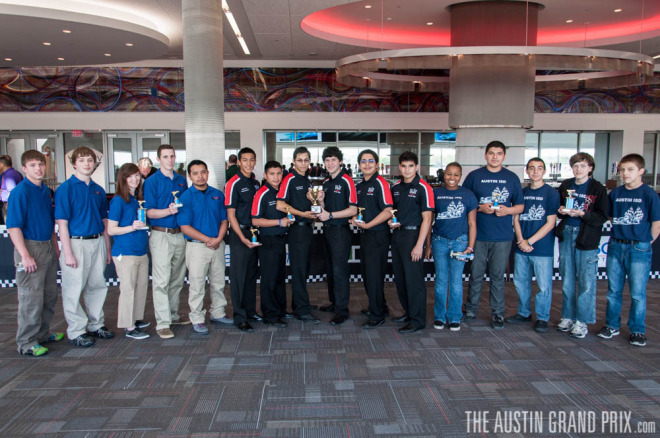 L-R: Axium Racing of Granbury High School, Team NOVA of PSJA Southeast High School and Talon Racing of Granbury High SchoolF1 in Schools, the leading global educational initiative in Science, Technology, Engineering and Mathematics ("STEM"), held its Texas Regional competition at Circuit of The Americas on March 23. The worldwide program aims to create a fun and exciting learning environment for students aged 9 to 19 to develop hands-on experience with STEM-focused careers partnered with business skills such as marketing and sponsorship and prepare them to compete against other teams, mirroring the Formula 1 industry.
L-R: Axium Racing of Granbury High School, Team NOVA of PSJA Southeast High School and Talon Racing of Granbury High SchoolF1 in Schools, the leading global educational initiative in Science, Technology, Engineering and Mathematics ("STEM"), held its Texas Regional competition at Circuit of The Americas on March 23. The worldwide program aims to create a fun and exciting learning environment for students aged 9 to 19 to develop hands-on experience with STEM-focused careers partnered with business skills such as marketing and sponsorship and prepare them to compete against other teams, mirroring the Formula 1 industry.
Teams of 3-6 students design and manufacture a model F1 car using 3D computer-aided design and computer-aided manufacturing programs and then test the aerodynamics of their design in a Virtual Reality Wind Tunnel using computational fluid dynamics (CFD) software. After analyzing the design for efficiency and performance, a block of balsa wood is put into a computer numerical controlled router, or CNC. These CNC machines cut the 2-D models into 3-D models for racing. The cars are powered by compressed air in the form of CO2 cartridges in order to race down down the 65' (20m) track in less than 2 seconds. In addition to finding the optimal aerodynamic features, the cars must adhere to specific weight and measurement standards, similar to the rules and regulations that make Formula 1 the sport that it is today.
Saturday's competition was hosted by SAE International and welcomed eight teams from across the state: XLR8 Racing and Axium Racing (Granbury High School); Talon Racing (Akins High School); Los Compadres and The Eclipse (Reagan High School); RED SHIFT (Pflugerville High School), J-Conn (John B. Connally High School); and Team Nova (PSJA Southweat High School). This 2013 Texas Regional Formula One Technology Challenge resulted in three winners qualifying to advance to the US National Championship at the Michigan International Speedway in May: Team Nova (First Place), Axium Racing (Second Place) and Talon Racing (Third Place).
We sat in on a few verbal presentations from the teams and were impressed by the collegiality between students of various ages and backgrounds. Successful team members knew it wasn't just about racing their car down the track; they explained how they stepped outside their assigned roles to help each other in building their team. This proved to be a vital element as teams aren't judged solely on the speed of the car, they're judged on their Portfolio (project management, team work, portfolio clarity and quality), Marketing (team identity, marketing and pit display) and the F1 car design process (ideas, development, testing and evaluation).
However, we'd be remiss if we didn't recognize the thrill of launching the car after the lights go out on track. That's right, just like in F1, five red lights light up one by one above the starting line of the track and when the lights go out, the "Driver's" reaction time is tested to 1/1000th of a second to hit the button and launch the car. The cars have small hooks on their undercarriage with a tether line run underneath it, and this tether line runs down the length of the track. This prevents cars from going airborne off the track. Cars are raced four times and another formula calculates points from the reaction race time and the total race time. Even with all the regulation, it is great fun!
The F1 in Schools program operates in over 40 countries and each National Champion is invited to compete at the World Finals, which will be held in Austin prior to the Formula 1 United States Grand Prix this November. This mirrors the global appeal of Formula 1, and also like F1, the F1 in Schools program is governed by technical documents (US Competition Regulations - 46 pages; US Technical Rules & Regulations - 36 pages), teams are lead by a Team Manager, and sponsorship dollars can make a difference when it comes to marketing the team and the car. After a "day at the track," one can see how this program is a leading example of leveraging STEM subject matter to real world racing and we're looking forward to the World Finals in Austin later this year.
